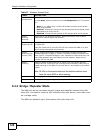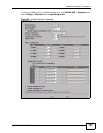
Chapter 8 Wireless Configuration
NWA-3500/NWA-3550 User’s Guide
125
RTS/CTS
Threshold
The threshold (number of bytes) for enabling RTS/CTS handshake. Data
with its frame size larger than this value will perform the RTS/CTS
handshake. Setting this attribute to be larger than the maximum MSDU
(MAC service data unit) size turns off the RTS/CTS handshake. Setting
this attribute to its smallest value (256) turns on the RTS/CTS
handshake. Enter a value between 256 and 2346.
This field is not available when Super Mode is selected.
Beacon
Interval
When a wirelessly networked device sends a beacon, it includes with it a
beacon interval. This specifies the time period before the device sends
the beacon again. The interval tells receiving devices on the network how
long they can wait in low-power mode before waking up to handle the
beacon. This value can be set from 20ms to 1000ms. A high value helps
save current consumption of the access point.
DTIM Delivery Traffic Indication Message (DTIM) is the time period after which
broadcast and multicast packets are transmitted to mobile clients in the
Active Power Management mode. A high DTIM value can cause clients to
lose connectivity with the network. This value can be set from 1 to 100.
Fragmentation
Threshold
The threshold (number of bytes) for the fragmentation boundary for
directed messages. It is the maximum data fragment size that can be
sent. Enter an even number between 256 and 2346.
This field is not available when Super Mode is selected.
Output Power Set the output power of the NWA in this field. If there is a high density of
APs in an area, decrease the output power of the NWA to reduce
interference with other APs. Select one of the following 100%, 50%,
25%, 12.5% or Minimum. See the product specifications for more
information on your NWA’s output power.
This field is not available when you select 802.11a in the 802.11 Mode
field.
SSID Profile The SSID (Service Set IDentifier) identifies the Service Set with which a
wireless station is associated. Wireless stations associating to the access
point (AP) must have the same SSID. Select an SSID Profile from the
drop-down list box.
Configure SSID profiles in the SSID screen (see Section 9.4 on page 143
for information on configuring SSID).
Note: If you are configuring the NWA from a computer connected to
the wireless LAN and you change the NWA’s SSID or security
settings, you will lose your wireless connection when you
press Apply to confirm. You must then change the wireless
settings of your computer to match the NWA’s new settings.
Table 27 Wireless: Access Point
LABEL DESCRIPTION


















